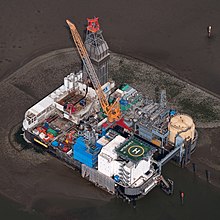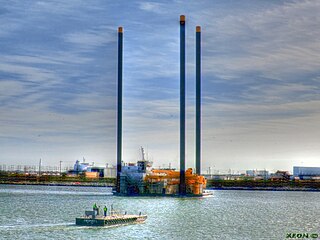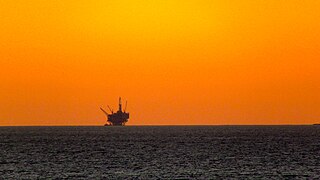
An accommodation platform is an offshore platform which supports living quarters for offshore personnel. [1] These are often associated with the petroleum industry, although other industries use them as well, such as the wind farm Horns Rev 2. [2]

An accommodation platform is an offshore platform which supports living quarters for offshore personnel. [1] These are often associated with the petroleum industry, although other industries use them as well, such as the wind farm Horns Rev 2. [2]
In the oil and gas industry an accommodation platform may be a flotel, providing living quarters for personnel temporarily engaged in construction or maintenance activities. It also refers to a permanent platform bridge-linked to production and wellhead platforms. It provides living quarters and a safe refuge remote from the potential hazards of the drilling and hydrocarbon plant.
Accommodation platforms may be designated 'A' (Accommodation), 'LQ' (Living Quarters), 'Q' (Quarters), 'UQ' (Utility & Quarters). Only low hazard equipment and fluids are located on the accommodation platform to reduce the risk of fire or explosion.

Accommodation platforms may comprise: [3]
Low hazard utility systems may be located on the Accommodation platform [3]
Consumable materials such as foodstuffs and potable water are delivered to the platform by supply boat, and are offloaded from the boat by platform mounted crane. The boat will also take waste material from the platform for recycling onshore.

An oil platform is a large structure with facilities to extract and process petroleum and natural gas that lie in rock formations beneath the seabed. Many oil platforms will also have facilities to accommodate the workers, although it is also common to have a separate accommodation platform linked by bridge to the production platform. Most commonly, oil platforms engage in activities on the continental shelf, though they can also be used in lakes, inshore waters, and inland seas. Depending on the circumstances, the platform may be fixed to the ocean floor, consist of an artificial island, or float. In some arrangements the main facility may have storage facilities for the processed oil. Remote subsea wells may also be connected to a platform by flow lines and by umbilical connections. These sub-sea facilities may include one or more subsea wells or manifold centres for multiple wells.

Offshore construction is the installation of structures and facilities in a marine environment, usually for the production and transmission of electricity, oil, gas and other resources. It is also called maritime engineering.

Saturation diving is diving for periods long enough to bring all tissues into equilibrium with the partial pressures of the inert components of the breathing gas used. It is a diving mode that reduces the number of decompressions divers working at great depths must undergo by only decompressing divers once at the end of the diving operation, which may last days to weeks, having them remain under pressure for the whole period. A diver breathing pressurized gas accumulates dissolved inert gas used in the breathing mixture to dilute the oxygen to a non-toxic level in the tissues, which can cause decompression sickness if permitted to come out of solution within the body tissues; hence, returning to the surface safely requires lengthy decompression so that the inert gases can be eliminated via the lungs. Once the dissolved gases in a diver's tissues reach the saturation point, however, decompression time does not increase with further exposure, as no more inert gas is accumulated.

Piper Alpha was an oil platform located in the North Sea about 120 miles (190 km) north-east of Aberdeen, Scotland. It was operated by Occidental Petroleum (Caledonia) Limited (OPCAL) and began production in December 1976, initially as an oil-only platform, but later converted to add gas production.

A platform supply vessel (PSV) is a ship specially designed to supply offshore oil and gas platforms and other offshore installations. They typically range from 50 to 100 metres in length and are distinguished by the large open deck area used to store supplies and house equipment and to allow for efficient loading and offloading. The primary function for most of these vessels is logistic support and transportation of goods, tools, equipment, and personnel to and from their destination.

A diving support vessel is a ship that is used as a floating base for professional diving projects. Basic requirements are the ability to keep station accurately and reliably throughout a diving operation, often in close proximity to drilling or production platforms, for positioning to degrade slowly enough in deteriorating conditions to recover divers without excessive risk, and to carry the necessary support equipment for the mode of diving to be used.
In the upstream oil industry, a gas–oil separation plant (GOSP) is temporary or permanent facilities that separate wellhead fluids into constituent vapor (gas) and liquid components.
The Clair oilfield is an offshore oil field in Scottish territorial waters 75 kilometres (47 mi) west of Shetland in water depths of up to 140 metres (460 ft). The field is the largest oilfield on the UK Continental Shelf with an estimated 8 billion barrels of oil-in-place, according to the BP Plc's website. It extends over an area of some 220 square kilometres (85 sq mi), covering five licence blocks.

A liftboat is a self-propelled, self-elevating vessel used in support of various offshore mineral exploration and production or offshore construction activities. A liftboat has a relatively large open deck to accommodate equipment and supplies, and the capability of raising its hull clear of the water on its own legs so as to provide a stable platform from which maintenance and construction work may be conducted.

Valhall is an oil field in the Norwegian sector of the North Sea. Discovered in 1975, production began in 1982 and is expected to continue until 2050. Valhall is located in 70 metres of water. It produces from chalk in the Tor and Hod Formations of Late Cretaceous age. The reservoir depth is approximately 2 400 metres.

Offshore drilling is a mechanical process where a wellbore is drilled below the seabed. It is typically carried out in order to explore for and subsequently extract petroleum that lies in rock formations beneath the seabed. Most commonly, the term is used to describe drilling activities on the continental shelf, though the term can also be applied to drilling in lakes, inshore waters and inland seas.
Subsea technology involves fully submerged ocean equipment, operations, or applications, especially when some distance offshore, in deep ocean waters, or on the seabed. The term subsea is frequently used in connection with oceanography, marine or ocean engineering, ocean exploration, remotely operated vehicle (ROVs) autonomous underwater vehicles (AUVs), submarine communications or power cables, seafloor mineral mining, oil and gas, and offshore wind power.
An oil production plant is a facility which processes production fluids from oil wells in order to separate out key components and prepare them for export. Typical oil well production fluids are a mixture of oil, gas and produced water. An oil production plant is distinct from an oil depot, which does not have processing facilities.
"Offshore", when used in relation to hydrocarbons, refers to operations undertaken at, or under the, sea in association with an oil, natural gas or condensate field that is under the seabed, or to activities carried out in relation to such a field. Offshore is part of the upstream sector of the oil and gas industry.

The Douglas Complex is a 54-metre (177 ft) high system of three linked platforms in the Irish Sea, 24 kilometres (15 mi) off the North Wales coast. The Douglas oil field was discovered in 1990, and production commenced in 1996. Now operated by Eni, the complex consists of the wellhead platform, which drills into the seabed, a processing platform, which separates oil, gas and water, and thirdly an accommodation platform, which is composed of living quarters for the crew. This accommodation module was formerly the Morecambe Flame jack-up drilling rig.
Offshore concrete structures, or concrete offshore structures, are structures built from reinforced concrete for use in the offshore marine environment. They serve the same purpose as their steel counterparts in oil and gas production and storage. The first concrete oil platform was installed in the North Sea in the Ekofisk oil field in 1973 by Phillips Petroleum, and they have become a significant part of the marine construction industry. Since then at least 47 major concrete offshore structures have been built.

Rampside Gas Terminal is a gas terminal situated in Barrow-in-Furness, Cumbria on the Irish Sea coast. It connects to gas fields in Morecambe Bay. It is situated adjacent to the former Roosecote Power Station.
Oseberg South is an offshore oil field in the North Sea, located 115 kilometres (71 mi) from the coastline and 13 kilometres (8.1 mi) south of Oseberg oil field. Oseberg Sør was discovered in 1984. The field was developed with a fixed production, drilling and quarters (PDQ) facility and is operated by Statoil. The first stage phase processing is done at the Oseberg Øst platform. The second and third phase processing of oil is done at the Oseberg Field Center and it is then transported to Sture Terminal in Norway through the Oseberg Transport System. The development of the Oseberg Sør was approved in 1977. Recent updates include approval of J structure which started producing in November 2006 and Oseberg Sør G Sentral which has been developed in 2009.

Commercial offshore diving, sometimes shortened to just offshore diving, generally refers to the branch of commercial diving, with divers working in support of the exploration and production sector of the oil and gas industry in places such as the Gulf of Mexico in the United States, the North Sea in the United Kingdom and Norway, and along the coast of Brazil. The work in this area of the industry includes maintenance of oil platforms and the building of underwater structures. In this context "offshore" implies that the diving work is done outside of national boundaries. Technically it also refers to any diving done in the international offshore waters outside of the territorial waters of a state, where national legislation does not apply. Most commercial offshore diving is in the Exclusive Economic Zone of a state, and much of it is outside the territorial waters. Offshore diving beyond the EEZ does also occur, and is often for scientific purposes.
Ocean development refers to the establishing of human activities at sea and use of the ocean, as well as its governance.